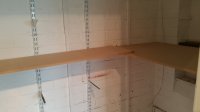ViolentPanda
Hardly getting over it.
Thank you.
So given its had two coats can I now skip that sealer I should have used and now just sand and revarnish? I've got sugar soap. Can I wash down with that after sending instead? Any milage in using an electric sander if I can borrow on for each coat or just man up and do it by hand?
Yep, you can skip the sealer, seeing as the wood has soaked up 2 coats.

Hand-sanding is better for just flatting varnish before applying another coat, because you only need a light touch - you're just looking to flat out little micro-bubbles and hairs - to do it. No need to wash down, just wipe down with a barely-damp cloth when you've finished sanding, and leave about ten minutes before applying the next coat.





